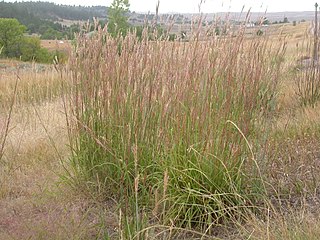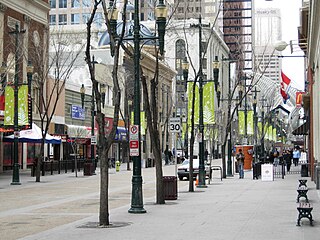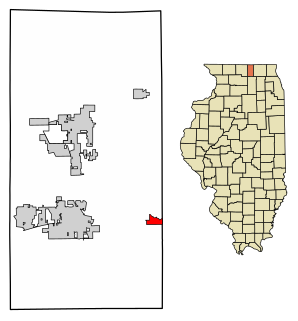
Prairies are ecosystems considered part of the temperate grasslands, savannas, and shrublands biome by ecologists, based on similar temperate climates, moderate rainfall, and a composition of grasses, herbs, and shrubs, rather than trees, as the dominant vegetation type. Temperate grassland regions include the Pampas of Argentina, Brazil and Uruguay, and the steppe of Ukraine, Russia and Kazakhstan. Lands typically referred to as "prairie" tend to be in North America. The term encompasses the area referred to as the Interior Lowlands of Canada, the United States, and Mexico, which includes all of the Great Plains as well as the wetter, hillier land to the east.

Portage la Prairie is a small city in the Central Plains Region of Manitoba, Canada. As of 2016, the population was 13,304 and the land area of the city was 24.68 square kilometres (9.53 sq mi). Portage la Prairie is approximately 75 kilometres (47 mi) west of Winnipeg, along the Trans-Canada Highway, and sits on the Assiniboine River, which flooded the town persistently until a diversion channel north to Lake Manitoba was built to divert the flood waters. The city is surrounded by the Rural Municipality of Portage la Prairie.

The tallgrass prairie is an ecosystem native to central North America. Natural and anthropogenic fire, as well as grazing by large mammals, were historically agents of periodic disturbance, which regulates tree encroachment, recycles nutrients to the soil, and catalyzes some seed dispersal and germination processes. Prior to widespread use of the steel plow, which enabled large scale conversion to agricultural land use, tallgrass prairies extended throughout the American Midwest and smaller portions of southern central Canada, from the transitional ecotones out of eastern North American forests, west to a climatic threshold based on precipitation and soils, to the southern reaches of the Flint Hills in Oklahoma, to a transition into forest in Manitoba.
The Linnaeus Arboretum, on the campus of Gustavus Adolphus College in Saint Peter, Minnesota, United States, contains a number of botanical gardens and an arboretum. The arboretum is named for Carl Linnaeus, Swedish botanist. Its first trees were planted as small seedlings in 1973 on agricultural land.

Andropogon gerardi, known commonly as big bluestem, turkeyfoot, tall bluestem, and bluejoint, is a tall grass native to much of the Great Plains and grassland regions of central and eastern North America.

The prairie vole is a small vole found in central North America.

The University of Michigan Matthaei Botanical Gardens includes botanical gardens, natural areas with trails, and several research-quality habitats. The conservatory is popular year round. The public entrance is at 1800 North Dixboro Road in Ann Arbor, Michigan. The grounds are open every day, but trails are not maintained in the winter. The conservatory, garden store, and lobby are open 7 days a week: Mon., Tues., and Thurs. - Sun., 10:00 am–4:30 pm; Wednesdays 10 am-8 pm. The building complex is only closed on three holidays a year. The institution's main web site with updated information is Matthaei Botanical Gardens.

The Morton Arboretum, in Lisle, Illinois, United States, is a public garden, and outdoor museum with a library, herbarium, and program in tree research including the Center for Tree Science. Its grounds, covering 1,700 acres, include cataloged collections of trees and other living plants, gardens, and restored areas, among which is a restored tallgrass prairie. The living collections include more than 4,100 different plant species. There are more than 200,000 cataloged plants.

The University of Wisconsin–Madison Arboretum is a teaching and research facility of the University of Wisconsin–Madison and the site of historic research in ecological restoration. In addition to its 1,260 acres (5 km2) in Madison, Wisconsin, the Arboretum also manages 520 acres of remnant forests and prairies throughout Wisconsin.

The Meyer May House is a Frank Lloyd Wright-designed house in the Heritage Hill Historic District of Grand Rapids, Michigan, in the United States. It was built in 1908-09, and is located at 450 Madison Avenue SE. It is considered a fine example of Wright's Prairie School era, and "Michigan's Prairie masterpiece".
The Japanese Elm cultivar Ulmus davidianavar.japonica 'Discovery' is a cold-resistant selection from Canada, raised along with 'Freedom' in the 1980s by Dr Wilbert Ronald, of Jeffries Nurseries Ltd. and Rick Durrand of Shade Consulting Services, Portage la Prairie, Manitoba.

The American Elm cultivar Ulmus americana 'Brandon' was raised by Lacombe Nurseries Lacombe, Alberta, Canada, before 1969; it may be synonymous with another cultivar from the same source known as 'Patmore', selected and raised by R. H. Patmore from a native tree in Brandon, Manitoba.
The Japanese Elm cultivar Ulmus davidianavar.japonica 'Freedom' is another cold-resistant selection from Canada, raised along with 'Discovery' in the 1980s by Dr Wilbert Ronald, of Jeffries Nurseries Ltd., and Rick Durrand of Shade Consulting Services, Portage la Prairie, Manitoba.
The Siberian Elm cultivar Ulmus pumila 'Harbin' is an older Manchurian selection superseded in the United States by 'Dropmore'.

The Ojibway Prairie Complex is a 350-hectare complex of parks and nature reserves on the west side of Windsor, Ontario, Canada. It comprises Ojibway Park, Tallgrass Prairie Heritage Park, Black Oak Heritage Park, Ojibway Prairie Provincial Nature Reserve, and the Spring Garden Natural Area.

Garden Prairie is an unincorporated former village located in Boone County, Illinois, United States. It is part of the Rockford, Illinois Metropolitan Statistical Area.

Prairie View is an unincorporated community located in northeastern Illinois, in southern Lake County. It is a part of Vernon Township. Prairie View has not been annexed entirely by either Lincolnshire or Buffalo Grove, although tiny portions of it have been.

Reptile Gardens is an animal park located south of Rapid City, South Dakota on the road to Mount Rushmore National Memorial. Reptile Gardens was cited in the 2014 Guinness Book of World Records for being the world's largest reptile zoo. It was recertified in the 2018 edition.

The B. Harley Bradley House is a Frank Lloyd Wright-designed home, constructed in the Prairie School style, that was constructed in Kankakee, Illinois in 1900–1901.
The Little Red River Cree Nation is a First Nations band government in northern Alberta, headquartered at John D'Or Prairie.














